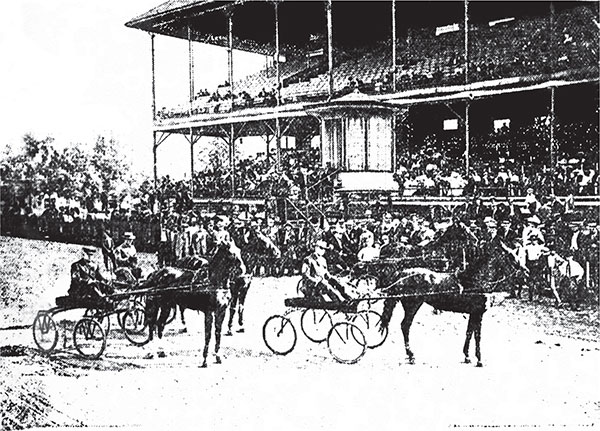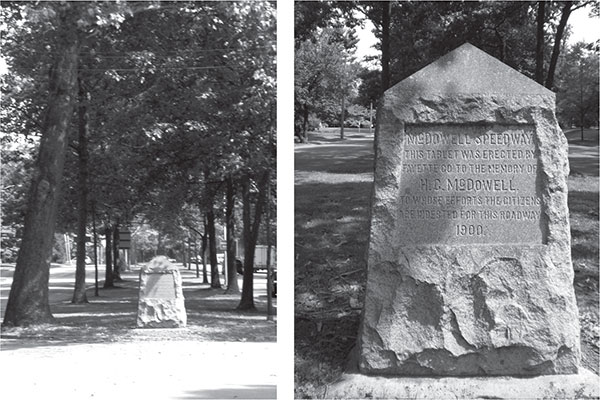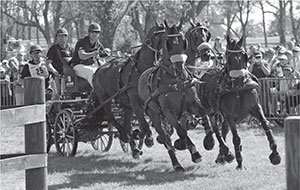
MCDOWELL SPEEDWAY
Before there were four-wheeled vehicles powered by engines racing around NASCAR speedways, there were four-wheeled carriages in races called speedways pulled by horses. Carriage races were not popular in the pioneer era in Kentucky for the lack of good roads; with the advent of large oval racetracks with level surfaces and paved roads, they became more frequent.
By the turn of the twentieth century, there was the League of Amateur Driving Clubs, with local clubs in many cities, including Boston, New York City, Syracuse, Pittsburgh, Chicago, Detroit, Memphis and Lexington.97
As early as 1872, match races were held on Lexington’s tracks. The Daily Press reported on a spirited four-heat race among five local men. The race had been moved for an unstated reason from the trotting track98 to Dr. Herr’s track.99 The unacknowledged reporter set the scene: “[Q]uite a respectable company assembled at the latter place about 3½ o’clock, and collecting in groups under the shady trees smoked cigars, ruminated, chewing the cud of sweet and bitter fine cut,100 and talked horse in a way that would have mystified any one but a thoroughbred Kentuckian.”
This was a “gentleman’s race,” with no betting permitted or betting pools sold. The five “reinsmen” were James C. Thompson driving a seven-year-old gelding, R.W. Preston with his four-year-old filly, Allie Hunt driving Cricket, A.J. Reed driving a brown gelding, and one Carrol—evidently well known, as his first name was not given—behind a four-year-old bay mare.
Timers, judges and a starter were selected, and the drivers drew lots for position. The first three lined up across and the last behind them. After the first heat was run, the horses were cooled off briefly, and they lined up for the second race. “The horses came thundering down the homestretch, rolling the dust in clouds from their heels. This time the winners of the first heat came in third and fourth. For the third heat the three slowest horses were allowed to start in front and tried to preserve a chance of winning by staying abreast and not allowing the faster horses through. However, one broke for the wire and the opening allowed a faster carriage to speed through and win.” The reporter, having breathlessly reported the race, concluded: “So ended the sport, and the drivers, having dusted themselves and donned their coats, came to town in good humor with themselves and each other. No bones were broken and no money was lost on the race. For mere roadsters, and driven, too, to heavy buggies, the time made was excellent, and no one has cause to be dissatisfied with his horse.”101
The 1904 summer Horse Show and Matinee Race meeting included “two speedway rings.” The events were only open to members of the Driving Club, and a total of sixteen silver julip cups were awarded. Curiously, the local Elks Club also arranged a mule race, described as a mile steeplechase race with objects and obstacles of various kinds being placed on the track “which the mules must jump, run over or balk at.” The Elks drum corps in red caps and coats and white trousers performed, and at the end there was a pony race for boys under fifteen years old.102
The Elks fair for 1902 included not only roadster (carriage) and harness horse races, but also saddlehorse and thoroughbred events, beef and dairy cattle, ponies and mules. Floral decoration prizes were also given for the best decorated two-horse, run about or road and pony carts.103
At this time, another significant trend was underway that would lead to a most unusual speedway. For decades, under state law, while a city maintained its streets, roads outside the city limits had been licensed or franchised to private toll road companies. In the later part of the nineteenth century, there was a movement to authorize the private companies to sell their interests to the government. This was encouraged by masked attacks on toll buildings and their operators—in Kentucky, these were called the “toll road wars.” Tollhouses were burned and toll keepers whipped.104 On July 23, 1897, the Fayette County Fiscal Court (the governing body) met to discuss buying three roads, the Richmond, Georgetown and Nicholasville pikes, with the goal of making travel free of tolls.105 The militant and unlawful attacks, of course, had the effect of reducing the prices of the rights-of-way. While the acquisition of the other roads was comparatively uneventful, Richmond Road’s acquisition took an interesting turn.

Carriages before a race. Lexington Herald, 1906.
Henry Clay’s Ashland farm was divided among heirs and some tracts retained by children and some sold. The main tract with his house became the property of Transylvania University and the site of its new college, Kentucky A&M (which eventually separated and became the University of Kentucky). By 1878, the two schools decided to split. The State of Kentucky took possession of Ashland and, giving the college a two-year lease, put it up for sale. The college took the offer of the city to move to the core of its present site.106 In 1882, Major Henry Clay McDowell and his wife, Ann Clay, daughter of Henry Clay Jr., purchased the 324-acre estate with an eye to restoring it, both house and grounds, after the hard use by the college.
The McDowells made many improvements to the estate, restored the equine breeding operation, built stables and made other improvements. A visitor in 1898 observed that “Ashland is probably in better condition today than when Henry Clay worked and planned, and superintended its fair acres.” Major McDowell also developed a “first-class” standardbred breeding farm.107 Standardbreds are used for carriage racing.
McDowell served in the Union army during the Civil War, rising to the rank of major. He had many business interests and was president of the Lexington and Eastern Railway. In 1883, he purchased Dictator, one of four major sons of standardbred champion Hambletonian and a major sire in his own right.
Across Richmond Road, which was in the process of being purchased by the county, lay the even larger estate of the Preston family, likely the family of the reinsman noted earlier. William Preston was one of the early investors in the new privately owned Lexington water company. A tract of his land on the south side of the road just past the Clay family property would become the lake for water service to Lexington.
The Lexington Hydraulic & Manufacturing Company was formed and began construction of a lake in a deep valley through which flowed the West Hickman Creek, erecting a dam along Mount Tabor Pike to the east. Over ten years, the reservoir’s system was expanded to more than two hundred acres. The company developed one shore of the lake into a public park and stocked the lake with fish. In the fall of 1897, it opened a new clubhouse on the property with an attached boathouse that extended one hundred feet into the lake. The second floor contained a locker room and beds for overnight stays by guests. The Lake Ellerslie Fishing Club was headquartered there.
In August 1897, McDowell purchased a fifty-foot-wide strip of land from Preston, running from the city limits two miles out along and beside Richmond Road to the lake. He then deeded the land to the county under the conditions that it construct an improved dirt road level with the road, that no streetcar or railroad was to be put in it and that the county would repair or replace farm fences taken down in the process. By the following spring, the newly improved way became a “pleasure drive” for carriages and trotting horses out to the lake. Carriage races with matched teams of horses would be held along this speedway, with crowds gathering to watch the finish. A Chicago newspaper called it “one of the best drives of its kind in the country.” The county contracted for it to be harrowed and worked in the summer “until it is almost as fast as a regulation track.”
The Elks Club hosted carriage races each year at the Kentucky Trotting Horse Association track (today’s Red Mile), and it openly encouraged the use of the speedway for training horses and for pleasure road driving. Many townspeople utilized it to go to the lake for events and picnics. No doubt it afforded McDowell great pleasure to drive his carriage, perhaps in local competition with Preston and others, out of his front gate and around his speedway.
McDowell was hardly alone in his sport. Wealthy men like New Yorkers Jerome Leonard and Billy Klair (founder of Belmont racecourse) were skilled coachmen who would drive their own four-horse heavy carriages, filled with guests, servants and food and drink to the track.108

McDowell Speedway/Richmond Road. The speedway was out on the right and back on the left. Right: H.C. McDowell monument. Photographs by author.
McDowell died in 1899. The following spring, H.H. Gratz, heir of Benjamin Gratz, for whom Gratz Park is named,109 appeared before the County Fiscal Court to request that the boulevard be known as the H.C. McDowell Speedway and a monument erected recognizing McDowell’s key role in the roadway improvements.110 The request was approved and the monument shown in the accompanying photographs erected, although between residential developments and road widenings the exact location has moved a couple of times.
With the advent of automobiles, carriage racing and equine use of the McDowell Speedway lessened. In the early decades of the twentieth century, both the McDowell and Preston farms were subject to residential subdivision, although the deeds to the Preston lands described them as fronting on the McDowell Boulevard. In 1911, the county paved Richmond Road with asphalt to the lake. The McDowell family resisted changes to the speedway, but in 1914, an agreement was reach with all property owners and the county for both the road and the speedway to be paved as a divided highway, the old road being one way out of town and the former speedway being one way in. Two years later, the roadways were widened to two lanes each and, eventually, crossing cuts were made in the parkway in between for residents, leaving new streets to cross over, a feature not needed when only large horse farms lined the way. The parkway was improved in 1914 with rows of trees.

Carriage Racing at the World Equestrian Games 2017, Kentucky Horse Park. David Stephenson.
In time, the memory of the McDowell Speedway dimmed, leaving only the monument as a reminder. Today’s automobile driver heading along Richmond Road for downtown Lexington has no notion that he is motoring down the speedway’s track.
As a final note, the first speeding ticket in Fayette County was issued on November 1, 1904, to one Alex G. Morgan for driving his automobile at an excessive speed down the McDowell Speedway.111